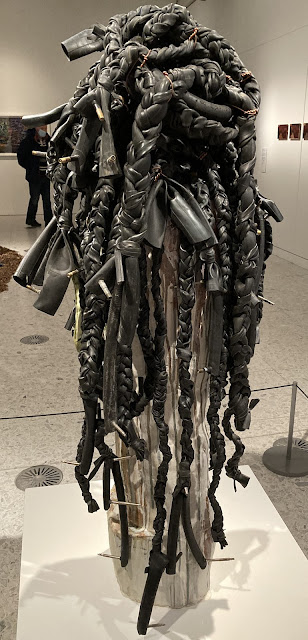Coventry Biennial 2021: Hyper Possible, at the Herbert Art Gallery, Coventry.
This exhibition brings together newly commissioned projects and existing artworks from national collections, creating an opportunity to look back at what has made Coventry and the surrounding area unique, while also reflecting on an increasingly complex global situation.
Luke Routledge, The Door in the Wall, 2021, (Animatronic installation)
Figures, creatures and objects populate a speculative and fictional universe. Using the notion of a constructed world or universe as a framework, the sculptures draw upon pseudoscience, philosophy and contemporary culture to stitch together a cast of inhabitants and their surrounding territory and civilisation.
A portal into the weird depths of Routledge's imagined realm opens onto an assembled party of anthropoorphic, hybrid creatures that frolic upon a clearing, drawing upon traditional sculpture, painting and cartoons in equal measure. A strawberry sprouts legs, a face bursts from their crown as a manu-hued minion carries a milkshake on its head. Nothing unusual here.
Johnson made this work during the Covid-19 lockdowns as part of a larger series that she describes as 'warm-up' drawings. She explains that this series is the equivalent of scales practice for a pianist.
She describes the process as 'working freely without too much reflection but at the same time with deep concentration', a method that allows for learning through practice'.
(Apologies for the reflection in the image)
Coventry and its surrounding areas have played a key role in the development of Rave and club culture, with the UK's first legal all-night party taking place in the city in October 1990.
The Cybernetic Culture Research Unit were particularly interested in a style of electronic music called Drum 'n' Bass that was being developed around this time. In the History of the World Jeremy Deller highlights social and political points of connection between Acid House and more traditional Bass Bands.
Untitled (Kuchu Series) continues Babirye's exploration of issues relating to identity, sexuality and human rights, all issues that Babirye has dealt with head-on in her life after fleeing Uganda folowing being outed in a local newspaper in 2005. With the support of the African Services Committee and the NYC Anti-Violence Project, she was granted asylum in New York in 2018.
This work uses a wide range of found materials that have been woven, whittled, welded, burned and burnished to think about belonging, family and identity and that aims to address the realities of being gay in the context of Uganda and Africa in general.
Obeah Man Revival is a recent example of British - Grenadian artist Denzil Forrester's expressive depictions of nightclubs. In this work, Forrester focuses on a DJ and four revellers whose distinctive clothing is characteristic of the dub and reggae scene that has inspired his work for over four decades.
Imagined here as an 'Obeah' or West Indian 'witch doctor', the DJ is the artist's eyes is 'the unifier of all the people in the space, giving energy and strength to all at the same time'.
Denzil Forrester, Still Here, 2019, (oil on canvas)
In this work, Forrester focuses on a DJ and his sound system, framed by a pair of Forresters trademark totemic speakers.
Jacob Epstein, Rabindranath Tagore, 1926, (bronze)
Rabindranath Tagore (1861-1941) was a famous Indian writer, artist, dramatist and social reformer. He was awarded the Nobel prize for literature in 1913.
Epstein worked in contrasting styles influenced by different materials. He modelled in clay in preparation for bronze pieces like this and the statue of St Michael and the Devil at Coventry Cathedral.
Matthew Krishanu, Young Tagore, 2013, (acrylic on paper)
While Krishanu's works speak to the legacies of the British Empire in a broad sense, there is also a personal connection, Krishanu's experiences growing up and living in Bradford, Birmigham and Dhaka, the capital of Bangladesh, all shaped by childhood memory, resonate strongly with the life of Tagore.
Much of Krishanu's practice is concerned with the canon of art history, particularly with reference to painting and to museum and gallery collections. His work probes some of the established and largely accepted narratives that exist in relation to racism, colonialism and power.
Matthew Krishanu, Tagore with Mrinalini Devi, 2013, (acrylic on paper)
Tagore with his wife Mrinalini Devi.
This drawing attempts to capture the energy and highlight the value of gay clubs in the 1980s. Gay clubs were (and continue to be) crucial spaces of education, exchange and expression for the LGBTQ + community.
Yeadon made the work at a time of institutional neglect and homophobia, when the AIDS epidemic was beginning to spread around the globe.
The experimental use of glitter, fluorescent paint, car spray paint and flashing coloured light bulbs add to the feeling of the viewer being in a disco.

















No comments:
Post a Comment